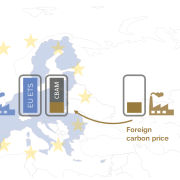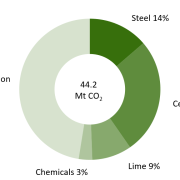Carbon management in Germany (I): from zero to climate and industrial necessity
This is the first article of a series on the potential of carbon capture, use and storage in Germany that will be published by carboneer over the coming weeks.
In this article, we look at the implications of a climate neutral Germany in 2045 on the demand for carbon management and carbon capture use and storage (CCUS). The topic has long been neglected in public debates but experiences a recent revival. CCUS can serve the dual purpose of (i) supporting the decarbonization of industrial facilities, and (ii) supplying especially the chemical sectors with CO2 as a resource for the production of primary products.
A brief history of carbon capture policy in Germany
While research on large-scale underground CO2 storage started in 2004 at the Ketzin pilot site close to Berlin, industrial carbon management activities (carbon capture, utilization and storage – CCUS) are virtually absent in Germany to the present. The European Union’s Carbon Capture and Storage Directive from 2009 provided its Member States with a framework to implement corresponding national legislation. The German Carbon Dioxide Storage Act (Kohlendioxid-Speicherungsgesetz – KSpG) came into force in August 2012 (cf. figure 1) but failed to establish favourable conditions for CCUS applications.
The storage discussion at that time in Germany was closely linked to the continuation of coal power generation and met strong public resistance. The expansion of renewable energy generation was at the center of potential mitigation pathways and CCUS applications were considered risky especially with regards to cost and safety criteria. Giving in to the general scepticism, the KSpG only allowed for applications with storage capacities below 1.3 million tons of CO2, and most states prohibited underground CO2 storage. No single storage project has been developed until the legal deadline for project submissions by the end of 2016. Currently it is therefore not possible to store CO2 underground in Germany and only a limited amount of capture and utilization projects are operative.
Carbon management has reemerged in the political arena in Germany only recently. The northwestern industrial state of North Rhine-Westphalia published its Carbon Management Strategy in 2021 and the National Carbon Management Strategy is currently being developed by the Federal Ministry for Economic Affairs and Climate Action (BMWK). We covered the national German Carbon Management Strategy in detail in this article.

Carbon Management is a central component of climate neutrality
With tightening climate targets at EU and German level, it is becoming increasingly clear that climate neutrality by mid-century or even 2045 will not be achieved without large-scale capture, utilization and long-term storage of CO2.
While CCUS experienced a slow uptake in German policymaking, academic research unanimously concludes that carbon management, including carbon capture, utilization and storage, as well as atmospheric carbon removal are necessary to reach climate targets. Since the electricity sector can be largely decarbonised through the expansion of renewables, the focus of carbon management in Germany lies on the industrial sector. Especially process-related emissions are hard to abate and might only be reduced through carbon capture solutions. Figure 2 shows the projections of five research projects on the sources of the CO2 that will be captured in 2045, at the time when Germany seeks to achieve climate neutrality.

Building up the capacity to capture between 35 and 70 Mt of CO2 from different industries, or 5-10% of current German GHG emissions, requires targeted and substantial investments over the coming two decades. Investments will only materialize if determined policy making creates an enabling investment environment and delivers clear rules and guidelines on topics such as:
- Incentive mechanisms for capture, utilization and storage
- Transport and storage infrastructure provision and regulation
- Regulation of CO2 imports and exports
- GHG accounting (especially in utilization projects)
From waste to resource: how much storage is actually needed?
While we will take a deep dive into different industrial sector’s CCUS conditions and dynamics in upcoming articles of this series, we already want to draw your attention to some insights from our latest analysis. The technical potential across German industries predestined for CCS applications (steel, cement, lime, chemicals, waste incineration) amounts to 40-50 Mt CO2. Here we consider process-related emissions only, as other emission can and must be decarbonised through other solutions, such as renewable energy, electrification, or green hydrogen.
On the other side, the demand for carbon in the chemical industry in Germany in 2045 is estimated to be approximately 50 Mt CO2. This already points to a new paradigm and an industrial ecosystem, where CO2 will not necessarily be sequestered and stored underground in northern Germany, under the North Sea or even being exported to Norway, Denmark, or the Netherlands. Quite the opposite, CO2 might become a scarce a raw material in the industrial carbon cycle pushing the demand for CCU applications. Furthermore, the updated regulation on the EU Emission Trading System allows regulated entities to use CCUS instead of surrendering emission allowances. Undoubtedly, this option further increases the demand for CCUS applications.
Consideration of policy interactions and emerging new industrial paradigms are crucial for a successful carbon management at the national and EU level. Topics that require further analysis are amongst others:
- Necessary CO2 transport capacity within Germany and Europe
- Ultimate storage capacities needed across Europe
- Quality criteria of CO2 for transport and utilization
- Build-up of capture, transport and storage capacities in sync
- Development of industrial carbon management clusters
The next article in this series on carbon management in Germany will deal with the current industrial emissions, the CCS potential in those industries and cost estimates for capture, transport, and storage. In the meantime, feel free to reach out with feedback and questions, which we are happy to discuss.
This article is based on a study by carboneer for the Trade Commissioner Service of the Canadian Embassy to Germany.
Sources:
BCG (2021) Klimapfade 2.0: Ein Wirtschaftsprogramm für Klima und Zukunft, Gutachten für den BDI. Available at: https://web-assets.bcg.com/58/57/2042392542079ff8c9ee2cb74278/klimapfade-study-german.pdf (Accessed: 25 March 2023).
Bundesregierung (2022) Evaluierungsbericht der Bundesregierung zum Kohlendioxid-Speicherungsgesetz: Drucksache 20/5145. Available at: https://dserver.bundestag.de/btd/20/051/2005145.pdf.
Deutsche Energie-Agentur (2021) dena-Leitstudie Aufbruch Klimaneutralität: Eine gesamtgesellschaftliche Aufgabe. Available at: https://www.dena.de/fileadmin/dena/Publikationen/PDFs/2021/Abschlussbericht_dena-Leitstudie_Aufbruch_Klimaneutralitaet.pdf (Accessed: 27 March 2023).
Fraunhofer ISI, Consentec and ifeu (2022) Langfristszenarien für die Transformation des Energiesystems in Deutschland: Modul 3: Referenzszenario und Basisszenario, Studie im Auftrag des Bundesministeriums für Wirtschaft und Energie. Available at: https://www.langfristszenarien.de/enertile-explorer-en/ (Accessed: 25 March 2023).
Luderer, G., Kost, C. and Sörgel, D. (2021) Deutschland auf dem Weg zur Klimaneutralität 2045 – Szenarien und Pfade im Modellvergleich: PIK: Potsdam-Institut fur Klimafolgenforschung. Available at: https://policycommons.net/artifacts/1860013/deutschland-auf-dem-weg-zur-klimaneutralitat-2045/2607518/ (Accessed: 28 March 2023).
Prognos, Öko-Institut, Wuppertal-Institut (2021) Klimaneutrales Deutschland 2045. Wie Deutschland seine Klimaziele schon vor 2050 erreichen kann: Zusammenfassung im Auftrag von Stiftung Klimaneutralität, Agora Energiewende und Agora Verkehrswende. Available at: https://www.agora-energiewende.de/veroeffentlichungen/klimaneutrales-deutschland-2045 (Accessed: 25 March 2023).








Leave a Reply
Want to join the discussion?Feel free to contribute!